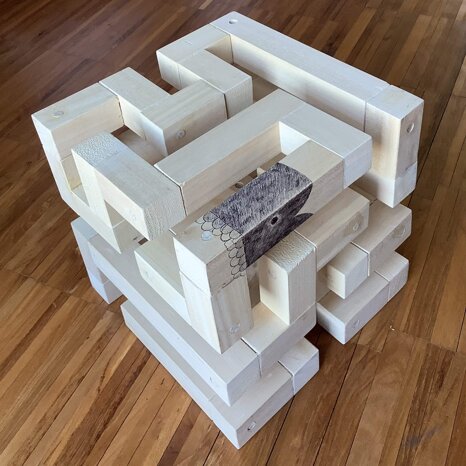postmaster@museumofanthropocenetechnology.org, via Leggiuno 32
Laveno Mombello
21014
Italia

The object represents in abstract form a serpent that has visited only once each of the 4 x 4 x 4 = 64 points of an imaginary 3-D matrix. In the case shown here, the serpent eventually bites in its own tail and forms a closed loop.
The serpent, that has a length of 508 cm and is 4 cm thick, is able to fold itself into a cube with a side of 28 cm.
There are many ways for the serpent to visit all 64 points: e.g. the serpent can start at any point of the matrix and go left or right, or up or down, etc. At the next point it has again the same choices.
The only way to know how many possibilities there are is by trying them one by one. The result is that here are a staggering 2,77 1016. possibilities (1016 means ten million billion!). In 5,79 1013 of those possibilities, the serpent will be able to bite in its tail: that means only (!) 2 out of 1000 possibilities. So, even if the number of possible closed loops is extremely high (tens of millions of millions!) the maker of this object was in fact quite lucky to find a closed loop!
Mathematicians study the many possibilities of folding because there is a link with proteins in living material. Proteins are initially long chains of amino acid molecules that fold into a specific compact structure which eventually determines the unique role of the protein (*).
A question one could ask is the following: how can a chain of amino acid molecules fold in just one unique structure, if we just saw that a serpent of 508 cm can fold itself in tens of millions of billions of ways into a cube of 28 cm? In fact, in the human body there are “only” some hundreds of thousands different proteins, not billions. So, the question is: why are there so “few” different proteins. The answer lays in the fact that a chain of amino acids is not like a serpent with a smooth skin. The various amino acids in the chain might by positively or negatively charged, or they can attract or repel water, so that they can attract or repel one another and fold their chain in a very specific way. The eventual specific and unique structure is determined by the sequence of amino acids in the chain. Predicting which form will result from a given sequence of amino acids has long been considered an irresolvable problem, but was in the end cracked in 02020 using artificial intelligence.
(*) Remember that the sequence of amino acids in one protein is determined by a sequence of T ,C, A ,and G molecules in DNA; called a gene. A combination of 3 out of the 4 T, C, A, and G molecules determines a specific amino acid. Life produces only 20 amino acids instead of the possible 64 (= possible combination of 3 out of 4). But “life”, in the form of researchers in the laboratory, started to synthesize the other amino acids and to build artificial proteins.
Nr. 51 - HAMILTONIAN 4x42018, MAT
Nr. 51 - HAMILTONIAN 4x4
2018, MAT
28 x 28 x 28 xm: wood
postmaster@museumofanthropocenetechnology.org, via Leggiuno 32
Laveno Mombello
21014
Italia